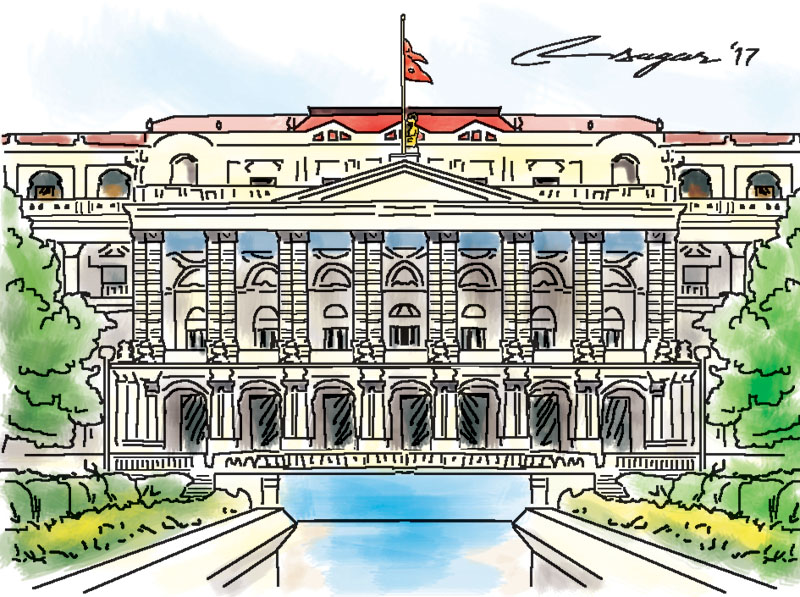Singha Durbar reconstruction: Retrofitting or reassembling
Nepal was not a British colony but this style of architecture entered into it right from the time of Bhimsen Thapa. It was emulated in the Bagh Durbar when constructed in 1805 with a tiger caged near the entrance and hence the name
The popularly known Gorkha earthquake is receding fast into the pages of history, but the scars left by it have in no way faded from the damage and destruction it caused. In fact, the scars appear deeper than before due to the reconstruction work only appearing to take off after being grounded for a long time. There are several factors responsible for this state of affairs, but one of them is the lack of conceptual and historic clarity of post reconstruction works, particularly of historic buildings like the Singha Durbar.
The Singha Durbar was constructed embracing the fascinating neo-classical style in the year 1903 in an incredibly less than two years’ time after the emergence of Chandra Shamsher in the political arena. It was said to be the largest building complex in South East Asia with more than 1000 rooms. It used traditional materials such as lime mortar blended with edible black lentils, thereby, creating a shortage of nutritional diet for women during maternity.
When it was gutted by fire in the early seventies, fire extinguishers had to take resort to explosives to extinguish it due to the use of such flammable material. The loss was so colossal that the then Prime Minister Kirtinidhi Bista had to resign on the basis of morality which has become virtually extinct in the modern Nepali politics.
The neo-classical style seeks to recreate the Roman or the Greek architecture. This architecture has its origin in the architecture of Greece, the epitome of which is Parthenon.
It was so stunningly beautiful that it was described as the gem in the crown of the mother earth by the poet Emerson. Neo-classical architecture is mainly a trinity consisting of orders in the form of the pillars, triangular pediments and cornices, among others. The pillars are the masculine looking Doric and Ionic without any or with few decorative elements respectively followed by the feminine and beautiful looking Corinthian with profuse floral ornaments. The Singha Durbar exhibits Corinthian order in its fabulous façade.
The architecture of Greece was adopted by the Romans in their empire, including in Britain, which later established it as its national architecture. Britain imposed it in their colonies almost worldwide as they proudly said that the sun never sets in the British Empire. When Delhi was being built as the capital of India around 1911, the parliament debated for days regarding the architectural style to be used. Some pleaded for the use of British neo-classical architecture to reflect their prowess while others opined to use the extremely rich, local, Indian architecture. A middle path was followed by making a marriage of the British and the Islamic architecture like that of Taj Mahal, the eighth wonder of the world. Consequently, buildings such as the palace of the Viceroy and the South Block exhibit the coexistence of the Indian Islamic domes and the Greek columns side by side.
Nepal was not a British colony but this style of architecture entered into it right from the time of Bhimsen Thapa. It was emulated in the Bagh Durbar when constructed in 1805 with a tiger caged near the entrance and hence the name. The devastation caused by the 1934 and the 2015 earthquakes in the majority of such palaces exposed their seismic vulnerability.
Any building which is hundred years old is labeled as historic and the Singha Durbar should be conserved properly as it has already seen 114 springs so far ignored which may invite public outrage. When Ananda Niketan constructed in the year 1892 was slated for demolition in the nineties, the conservationists had the last laugh as they brought the callous authorities down to their knees through its retention.
Conservation consists of several degrees of intervention measures two of which are Consolidation and Anastylosis. Consolidation also called retrofitting seeks to strengthen the existing structure in the event of future calamities.
The Shiva Temple of Golmadi, Bhaktapur was consolidated by introducing a reinforced concrete ring beam after its dome fell off like a cap blown by wind. Anastylosis also known as reassembly is about making an exhaustive recording of the monument, demolishing it and constructing it back to its original form and façade without the slightest departure through using only the original materials to all extent possible. The Shiva temple of Nasaman Dabu, Bhaktapur was conserved following this modus operandi.
Considerable time was lost in deciding whether to go for retrofitting or reassembly. Retrofitting was given a nod which cannot always be executed with perfection as amply demonstrated by the restoration of the Rabi Bhawan, the youngest of the neo-classical palaces constructed in the year 1941 suffered cracks in the 2015 earthquake and had to be retrofitted.
The Singha Durbar is representative of British architecture in Nepal and should be held in high esteem as Nepal would still have remained under suzerainty when it came into being in 1792, unlike a fully sovereign state now, had not Britain signed a treaty of peace and perpetual friendship with Nepal in 1923. This is also an occasion to pay tribute to that country that stood by us enabling us to exist at par with the other countries of the world.
Pokharel is Vice Chancellor of Nepal Academy of Science and Technology






